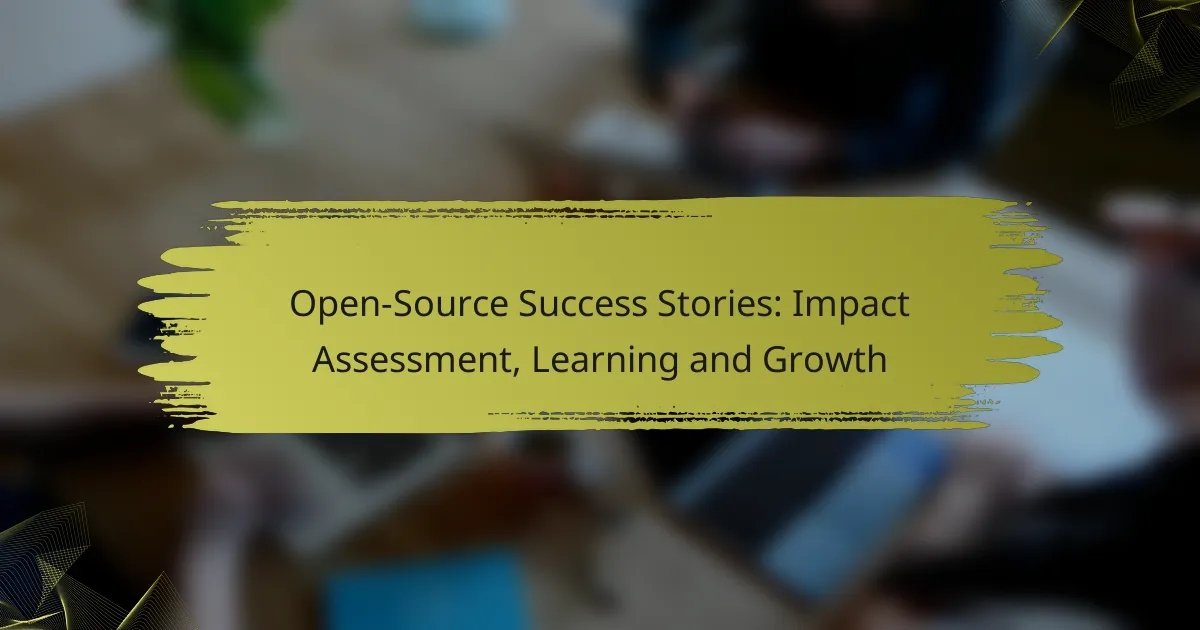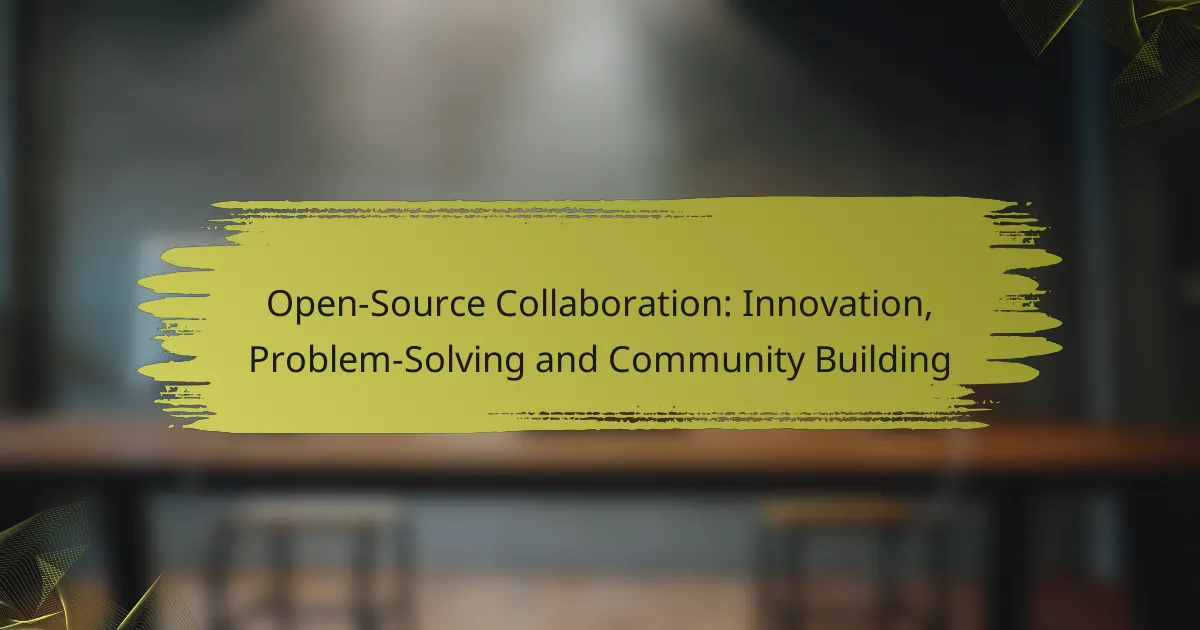Open-source projects play a crucial role in fostering community growth by promoting collaboration and skill enhancement among individuals. By measuring key impact metrics such as contribution rates and community engagement levels, stakeholders can assess the effectiveness and sustainability of these initiatives. This comprehensive evaluation not only guides decision-making but also highlights the significant contributions open-source projects make to both individual growth and the broader community.

How do open-source projects drive community growth?
Open-source projects foster community growth by encouraging collaboration, skill enhancement, networking, and practical experience. These elements create a vibrant ecosystem where individuals can contribute, learn, and connect with others in their field.
Increased collaboration opportunities
Open-source projects provide a platform for individuals from diverse backgrounds to collaborate on shared goals. This collective effort often leads to innovative solutions and improvements that benefit the entire community.
For example, contributors can work together on coding tasks, documentation, or project management, allowing them to share knowledge and skills. This collaboration can also lead to mentorship opportunities, where experienced developers guide newcomers.
Enhanced skill development
Participating in open-source projects allows individuals to develop and refine their technical skills in a real-world context. Contributors can learn programming languages, software development practices, and project management techniques by engaging with active projects.
Many projects also offer resources such as tutorials and forums, which can further enhance the learning experience. This hands-on approach to skill development is often more effective than traditional classroom settings.
Networking benefits
Engaging in open-source projects helps individuals expand their professional networks. Contributors often connect with like-minded peers, industry experts, and potential employers, which can lead to job opportunities and collaborations.
Networking within the open-source community can also provide access to conferences, workshops, and meetups, where individuals can share experiences and learn from one another. Building these connections is crucial for career advancement in technology fields.
Real-world project experience
Open-source projects offer contributors valuable real-world experience that can enhance their resumes. Working on these projects allows individuals to demonstrate their abilities in a practical setting, showcasing their problem-solving skills and technical knowledge.
Moreover, contributors can receive feedback from other community members, helping them improve their work and adapt to industry standards. This experience is often viewed favorably by employers looking for candidates with practical skills and a proactive attitude.

What are the key impact metrics for open-source success?
The key impact metrics for open-source success include contribution rates, user adoption statistics, and community engagement levels. These metrics help assess the effectiveness and sustainability of an open-source project, guiding developers and stakeholders in making informed decisions.
Contribution rates
Contribution rates measure the frequency and volume of contributions made to an open-source project, including code commits, documentation updates, and issue resolutions. A healthy project typically sees contributions from a diverse range of developers, often reflecting a vibrant community.
To evaluate contribution rates, consider tracking metrics such as the number of active contributors over time and the frequency of commits. A project with consistent contributions from both new and existing developers is likely to be more sustainable and innovative.
User adoption statistics
User adoption statistics indicate how widely an open-source project is being utilized. This can be assessed through metrics like download counts, active installations, and user feedback. High adoption rates often correlate with a project’s perceived value and usability.
For example, a project that sees thousands of downloads per month or has a growing user base on platforms like GitHub is generally considered successful. Monitoring user adoption can help identify trends and areas for improvement, ensuring the project meets user needs effectively.
Community engagement levels
Community engagement levels reflect how actively users and contributors interact within the project’s ecosystem. This can include participation in forums, mailing lists, and events, as well as the responsiveness to user inquiries and contributions.
Engagement can be measured through metrics such as the number of discussions, pull requests, and issue resolutions. A project with high community engagement is likely to foster collaboration and innovation, making it more resilient and adaptable to changes in technology and user requirements.

How do organizations measure the impact of open-source initiatives?
Organizations measure the impact of open-source initiatives through various methods that assess both qualitative and quantitative outcomes. These approaches help in understanding user satisfaction, performance improvements, and overall contributions to the community.
Surveys and feedback
Surveys and feedback mechanisms are essential tools for gauging the impact of open-source initiatives. Organizations often deploy surveys to collect insights from users and contributors, focusing on their experiences and satisfaction levels. This direct feedback can highlight strengths and areas for improvement, guiding future development efforts.
To maximize response rates, consider using concise questionnaires and incentivizing participation. Aim for a mix of quantitative questions (like rating scales) and qualitative open-ended questions to capture a broad range of insights.
Performance analytics
Performance analytics involves tracking specific metrics that reflect the effectiveness of open-source projects. Key performance indicators (KPIs) may include download counts, contribution rates, and issue resolution times. Monitoring these metrics allows organizations to identify trends and measure growth over time.
Utilizing tools like GitHub Insights or Google Analytics can provide valuable data. Set benchmarks for these metrics to evaluate progress, and regularly review them to adapt strategies as necessary.
Case studies
Case studies offer in-depth examinations of specific open-source initiatives, showcasing their impact on organizations or communities. By documenting successes and challenges, case studies provide valuable lessons and best practices that can be shared with others.
When creating case studies, focus on clear narratives that outline objectives, methodologies, and outcomes. Include quantitative data where possible, such as percentage increases in user engagement or cost savings, to substantiate claims and provide concrete examples of impact.

What are successful open-source case studies in the tech industry?
Successful open-source case studies in the tech industry showcase how collaborative software development can lead to innovative solutions and significant growth. These projects demonstrate the power of community-driven efforts, resulting in widely adopted technologies that have transformed various sectors.
Linux operating system
The Linux operating system is a prime example of open-source success, powering a vast majority of servers and devices worldwide. Its modular architecture allows developers to customize and optimize the OS for various applications, from embedded systems to supercomputers.
Linux’s community-driven model encourages contributions from individuals and organizations, fostering rapid innovation. Companies like Red Hat and Canonical have built successful business models around Linux, offering support and services that enhance its adoption in enterprise environments.
Apache web server
The Apache web server is one of the most widely used web servers globally, known for its reliability and flexibility. It supports a variety of operating systems and can be configured to meet diverse hosting needs, making it a staple for web developers.
Apache’s open-source nature allows developers to modify the source code, leading to a rich ecosystem of modules and extensions. This adaptability has contributed to its longevity, with a significant share of websites relying on Apache for their hosting solutions.
Kubernetes container orchestration
Kubernetes has emerged as a leading platform for container orchestration, simplifying the deployment and management of applications in cloud environments. Its open-source framework allows organizations to automate scaling, load balancing, and resource allocation, enhancing operational efficiency.
The Kubernetes community continuously contributes to its development, ensuring it evolves to meet the demands of modern software architectures. Companies leveraging Kubernetes can achieve greater agility and resilience in their operations, making it a cornerstone of cloud-native development.

What are the prerequisites for launching an open-source project?
To successfully launch an open-source project, you need a clear understanding of your goals, a committed team, and a well-defined plan for community engagement. These prerequisites set the foundation for effective collaboration and project sustainability.
Clear project goals
Establishing clear project goals is essential for guiding development and attracting contributors. Goals should be specific, measurable, achievable, relevant, and time-bound (SMART) to ensure clarity and focus.
Consider defining the primary purpose of your project, such as solving a particular problem or improving existing solutions. For example, if your goal is to create a library for data visualization, specify the types of data it will handle and the platforms it will support.
Regularly revisit and refine your goals based on community feedback and project progress. This adaptability helps maintain momentum and ensures that the project remains aligned with user needs and technological advancements.



